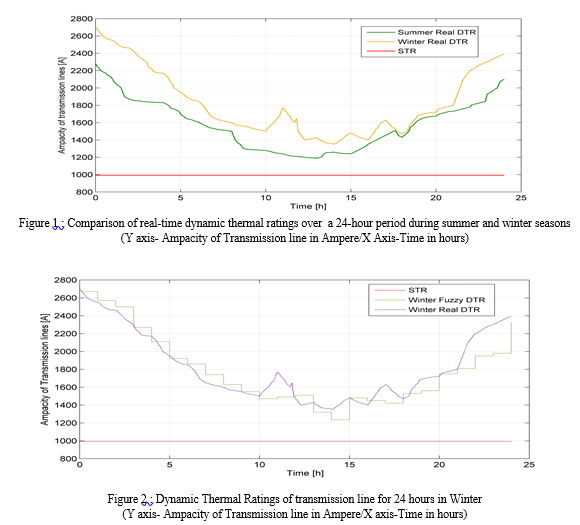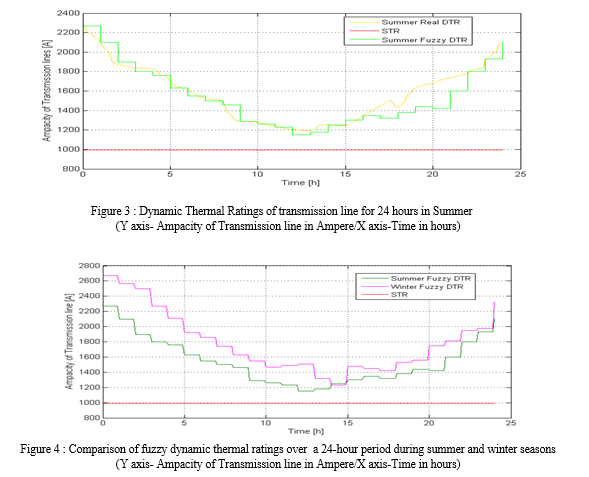Ijraset Journal For Research in Applied Science and Engineering Technology
- Home / Ijraset
- On This Page
- Abstract
- Introduction
- Conclusion
- References
- Copyright
Fuzzy Logic-Based Dynamic Thermal Rating Assessment for Adaptive Grid Operations
Authors: Lakhyahira Baishya , Purobi Patowary
DOI Link: https://doi.org/10.22214/ijraset.2024.62066
Certificate: View Certificate
Abstract
In recent times, there has been a notable increase in electricity demand, which is expected to continue rising. This uptick in demand has led to transmission lines operating at higher capacities, exposing them to greater thermal and mechanical stress and affecting the reliability of the transmission network. This paper presents an in-depth analysis of the static thermal rating (STR) and dynamic thermal rating (DTR) of power lines across various climatic conditions. The study investigates the thermal behavior of power lines during both summer and winter seasons over a 24-hour period. Through computational simulations and empirical data collection, the study determines the STR and DTR profiles to evaluate the real-time capacity of power lines under changing environmental conditions. Additionally, the research introduces a novel approach using fuzzy logic to model the dynamic thermal rating (FDTR) based on the IEEE 738 standard, particularly in regions with diverse climatic patterns. By integrating fuzzy logic with meteorological data, the FDTR model improves accuracy in predicting the thermal performance of power lines, considering factors like ambient temperature, wind speed, and solar radiation. This methodology aims to offer utilities and grid operators a reliable tool for optimizing power transmission capacity, reducing the risk of overheating, and ensuring grid reliability in areas with complex and fluctuating weather conditions. The study contributes to the advancement of smart grid technology and facilitates efficient energy management in diverse climate zones.
Introduction
I. INTRODUCTION
Meeting the escalating demand for electricity sustainably necessitates the evolution of electric power networks. Incorporating renewable energy sources into existing infrastructures without compromising overhead conductors presents a viable solution. To tackle this challenge, power utilities must adopt innovative and adaptable network enhancement strategies [1], striving to bolster power transfer capabilities while minimizing the need for substantial investments in new assets. The overarching aim is to transition conventional power networks into flexible smart systems capable of efficiently accommodating diverse and expanding energy demands.
Electric power transmission systems rely on two primary methods to determine transmission line capacity: Static Thermal Rating (STR) and Dynamic Thermal Rating (DTR). While STR establishes a fixed maximum capacity based on limited environmental assumptions, DTR introduces a dynamic approach by integrating real-time weather data and advanced algorithms [2]. This dynamic method not only boosts line capacity but also facilitates proactive planning and control, ushering in an era of enhanced reliability and sustainability in energy transmission.
Shifting from fixed load demand to Dynamic Thermal Rating (DTR) coupled with demand-side management enhances the responsiveness and safety of power systems [3]. By enabling active control over flexible resources on the load side, DTR ensures the safe operation of power equipment. Furthermore, integrating storage technologies and management systems enhances reliability and utilization of electric power [4]. Research suggests that DTR plays a pivotal role in integrating renewable energy sources, particularly wind turbines, into the grid [5]. This integration not only meets additional load demands but also maintains financial viability during emergencies, thereby reducing the need for additional transmission assets. Additionally, compared to constructing new lines or upgrading major infrastructure, implementing DTR proves to be a cost-effective solution, offering numerous benefits in terms of efficiency, reliability, and cost-effectiveness [6].
Enhancing the load-carrying capacity of overhead transmission lines (OHL) while managing conductor temperatures is crucial for ensuring the reliability and economic viability of power systems. The dynamic line rating approach offers practical solutions for meeting increasing load demands but also poses challenges due to potential excessive conductor temperatures, accelerating degradation mechanisms such as annealing and aging. The rate of component aging directly correlates with the magnitude and duration of thermal overload, emphasizing the importance of addressing conductor thermal behavior. As highlighted in [7], the progressive deterioration of electric components severely impacts system reliability and economics.
Ongoing research efforts are essential for improving OHL load capacity and mitigating thermal stress and aging effects on conductors [8]. Various studies have been conducted to address these challenges and enhance the performance of the line rating of transmission systems [9].
Assessing Dynamic Thermal Ratings (DTR) encounters significant uncertainty due to sparse distribution of sample stations along transmission lines, measurement inaccuracies, and unpredictable weather fluctuations. To attain a more precise estimation of line ratings and conductor temperatures, it's imperative to incorporate uncertainties into computations. Fuzzy sets have emerged as a preferred approach for modeling uncertainty inherent in meteorological data, enhancing the versatility and effectiveness of fuzzy-based approaches in addressing transmission line management challenges [10].
Researchers often utilize the heat balance equation of overhead line conductors to examine their thermal characteristics, estimating conductor temperatures under varying conditions [11]. Real-time monitoring of meteorological conditions enables the calculation of dynamic thermal ratings, deepening understanding of line thermal behavior.
This research employs static thermal rating to determine maximum permissible current under steady-state conditions and investigates Dynamic Thermal Rating to assess the conductor's capability to handle varying load conditions over time. Fuzzy Dynamic Thermal Rating techniques are utilized to address uncertainties associated with dynamic thermal rating, providing a nuanced understanding of thermal performance, particularly in diverse climatic regions [12].
II. METHODOLOGY
A. Theory of Dynamic Thermal Rating System
The determination of the steady-state dynamic thermal rating (DTR) of exposed overhead conductors aligns with IEEE 738 standard guidelines [11], incorporating meteorological variables. DTR is influenced by factors like solar heat absorption, convective heat dissipation, radiative heat exchange, and conductor current flow. In stable environmental conditions, the conductor's current capacity is determined by the balance between heat gain and loss, as outlined in the steady-state heat balance equation for the conductor.
Qc (Tc,Ta,Vw,φ) + Qr(Ta,Tc) - Qs( ω)- I2R(Tc) =0 (1)
In the equation (1), Qc signifies heat loss through convection, while Qr denotes radiation-induced heat loss. Conversely, Qs represents heat gain through radiation, and I2R(Tc) illustrates heat generated by current flow within the conductor, where I represent the maximum allowable current, equivalent to the line rating. These thermal factors rely on various meteorological variables, including ambient temperature (Ta), solar radiation angle (ω), wind speed (Vw), and incident wind angle (φ) relative to the line. Moreover, the conductor's temperature (Tc) and its resistance (R), which fluctuates with temperature, significantly influence these thermal effects.
Hence, Equation (1) facilitates determining the maximum permissible current for the conductor under prevailing weather conditions. The acceptable temperature range for the conductor may differ between steady-state and dynamic scenarios, resulting in distinct permissible currents for each condition.
B. Assessment of heat loss rate
The convective heat loss rate of a conductor is influenced by several variables, including wind speed and direction, air and conductor temperature, dynamic viscosity, air density, and conductor diameter. These factors play a crucial role in determining the maximum heat loss rate applicable under different wind conditions [11]. Additionally, the radiated heat loss rate is dependent on the conductor's diameter, ambient and conductor temperatures, conductor absorptivity which is denoted as α. The surface darkness of the conductor affects its heat absorption capability, thereby influencing radiated heat loss. Typically, the parameter α falls within the range of 0.23 to 0.91, varying based on the surface condition of the conductor.
C. Assessment of solar heat gain rate
Solar heat intensity fluctuates with seasonal and daily variations, influenced by factors like the conductor's projected area (Ar), latitude (Lat), and solar absorptivity (α), which is analogous to emissivity (ε). Latitudes typically range from -90 to +90 degrees, while solar declination varies from 0 to 90 degrees. Critical determinants impacting heat flux density encompass solar altitude (Hc), hourly angle (ω), and atmospheric clarity, detailed in [11].
When considering uncertainty, it's customary to utilize fuzzy numbers, representing ranges of values for a more nuanced comprehension of the involved variables. Further elucidation of the equations is provided in [10].
III. EXPERIMENTAL RESULTS AND DISCUSSION
To illustrate the real-world application of thermal rating forecasting, let's analyze a 100km portion of a power transmission line in Assam, India, where diverse weather conditions prevail. The chosen conductor is the Drake ACSR conductor, and factors such as wind speed, wind direction, ambient temperature, and solar radiation angle are determined based on the climatic characteristics of the Assam region. The maximum line loading is capped at 3000A, with an extra transmission capacity reserve of 10% [13].
In Assam, transmission lines outfitted with ACSR conductors are engineered to sustain a maximum static rating of 992A each conductor. This rating is determined through calculations that project the conductor's temperature reaching 75 0C under specific conditions. These conditions include a presumed wind speed of 3.6m/s, an ambient temperature of 27 0C, and a solar radiation intensity of 1024 W/m2 [14].
Figure 1 presents a comparison of dynamic thermal ratings for both summer and winter seasons, highlighting their deviation from the static thermal rating. Notably, it shows that the dynamic thermal rating is higher in winter compared to summer. To mitigate the uncertainty surrounding dynamic thermal ratings, fuzzy dynamic thermal rating is employed. Figure 2 illustrates the contrast between fuzzy dynamic thermal rating, real-time dynamic thermal rating, and static thermal rating during the winter months, while Figure 3 showcases the comparison during the summer period. Additionally, Figure 4 demonstrates the variation of fuzzy dynamic thermal rating throughout both winter and summer seasons.


In Figure 1, the dynamic thermal ratings exhibit a gradual decline over the first 9 hours in both summer and winter seasons. However, a notable disparity arises at the 11-hour mark, with winter's Real DTR recorded at 1770A and summer's at 1240A. Subsequently, starting from the 21th hour, the dynamic thermal ratings begin to rise. This discrepancy at the 11-hour mark between winter and summer dynamic thermal ratings could stem from variations in temperature and load conditions. Typically, winter temperatures are lower, leading to higher dynamic thermal ratings due to enhanced cooling efficiency. Moreover, seasonal differences in load patterns may influence the overall stress on the transmission lines. In Figure 2, during the winter season, at 13th hour, the fuzzy dynamic thermal rating registers 1320A, contrasting with the real DTR of 1430A. Such fluctuations may result from various factors, including changes in environmental conditions, power consumption patterns, or adjustments within the fuzzy logic control system. In Figure 3, the lowest dynamic thermal rating reaches 1190A at the 13th hour. In Figure 4, the curves of fuzzy dynamic thermal rating converge at the 14th hour in both winter and summer seasons, possibly due to consistent environmental conditions, balanced power demand, or optimizations made within the fuzzy logic control system to enhance thermal performance.
Conclusion
This study conducted a comprehensive analysis of the steady-state thermal rating and dynamic thermal rating over a 24-hour period, examining both summer and winter seasons. The comparison of these ratings between seasons provided valuable insights into the thermal characteristics of the system under varying climatic conditions, as observed in regions such as Assam. For instance, at the 18th hour, the real-time dynamic thermal rating was found to be 1470 A in winter and 1410 A in summer. Additionally, in acknowledgment of the uncertainties inherent in dynamic thermal rating, the study proposed a novel approach: fuzzy dynamic thermal rating. This method presents a robust framework for addressing uncertainties by accommodating the variability of climatic conditions and their effects on thermal ratings. Through the integration of fuzzy logic principles, the fuzzy dynamic thermal rating captures the intricate interplay of factors influencing thermal performance, providing a more nuanced understanding of system behavior. The study\'s findings contribute to the advancement of thermal rating methodologies, particularly in regions with diverse and challenging climatic environments like Assam, ultimately improving the reliability and efficiency of power infrastructure in such areas. In considering future prospects, there lies an opportunity to merge renewable energy resources, leverage smart grid technologies, deploy machine learning algorithms for predictive analytics, craft optimization strategies, carry out on-site experiments, evaluate policy implications, delve into resilience tactics, and evaluate environmental consequences. This holistic approach aims to propel the comprehension and application of dynamic thermal ratings, particularly in regions characterized by varied climatic dynamics.
References
[1] P. Patowary, Dynamic thermal rating and allowable operating time under transient conditions, in 2014 Eighteenth National Power Systems Conference (NPSC) IEEE,2014, pp.1-6. [2] O. A. Lawal , J. The, Dynamic Thermal Rating Forecasting Methods: A Systematic Survey, in IEEE Access, vol. 10,2022, pp. 65193-65205 [3] Lai, C.M., Teh, J., Comprehensive Review of the Dynamic Thermal Rating System for Sustainable Electrical Power Systems. Energy Rep. 2022, 8, 3263–3288. [4] Khoo, W.C ,Teh, J., Lai, C.M. Demand Response and Dynamic Line Ratings for Optimum Power Network Reliability and Ageing. [5] IEEE Access 2020, 8, 175319–175328. [6] Teh. J., Cotton, I. Reliability Impact of Dynamic Thermal Rating System in Wind Power Integrated Network. IEEE Trans. Reliab.2016, 65, 1081–1089. [7] Teh, J., Lai, C.M., Muhamad, N.A., Ooi, C.A., Cheng, Y.H., Zainuri, M.A.A.M., Ishak, M.K. Prospects of Using the Dynamic Thermal Rating System for Reliable Electrical Networks: A Review. IEEE Access 2018, 6, 26765–26778. [8] Musilek, P., Heckenbergerova, J., Bhuiyan, M.M.I. Spatial Analysis of Thermal Aging of Overhead Transmission Conductors. IEEE Trans. Power Deliv. 2012, 27, 1196–1204 [9] Erdinç, F.G., Erdinç, O., Yumurtac?, R., Catalão, J.P.S. A Comprehensive Overview of Dynamic Line Rating Combined with Other Flexibility Options from an Operational Point of View. Energies 2020, 13, 6563. [10] Zainuddin, N.M.; Rahman, M.S.A., Kadir, M.Z.A.A.,Ali, N.H.N., Ali, Z., Osman, M.; Mansor, M., Ariffin, A.M., Nor, S.F.M., Nasir, N.A.F.M. Review of Thermal Stress and Condition Monitoring Technologies for Overhead Transmission Lines: Issues and Challenges. IEEE Access 2020, 8, 120053–120081 [11] Shaker, H., Fotuhi-Firuzabad, M., Aminifar, F. Fuzzy Dynamic Thermal Rating of Transmission Lines. IEEE Trans. Power Deliv.2012, 27, 1885–1892. [12] IEEE Std 738TM-2012; IEEE Standard for Calculating the Current-Temperature Relationship of Bare Overhead Conductors .Committee of the IEEE Power; IEEE Power and Energy Society: New York, NY, USA, 2012. [13] Bell, K.R.W., Daniels, A.R., Dunn, R.W. Alleviation of Transmission System Overloads Using Fuzzy Reasoning. Fuzzy Sets Syst.1999, 102, 41–52. [14] Larruskain, D.M.; Zamora, I.; Abarrategui, O.; Iraolagoitia, A.; Gutiérrez, M.D.; Loroño, E.; de la Bodega, F. Power Transmission Capacity Upgrade of Overhead Lines. Renew. Energy Power Qual. J. 2006, 1, 221–227. [15] L. Baishya, P. Patowary, D. Saikia, Temperature Fluctuations in Power conductors: Analysis and Overcurrent Relay Adaptation Strategies for Mitigation, IJFMR, Vol 6 (3), 2024. DOI 10.36948/ijfmr.2024.v06i03.19641
Copyright
Copyright © 2024 Lakhyahira Baishya , Purobi Patowary. This is an open access article distributed under the Creative Commons Attribution License, which permits unrestricted use, distribution, and reproduction in any medium, provided the original work is properly cited.

Download Paper
Paper Id : IJRASET62066
Publish Date : 2024-05-14
ISSN : 2321-9653
Publisher Name : IJRASET
DOI Link : Click Here
 Submit Paper Online
Submit Paper Online

